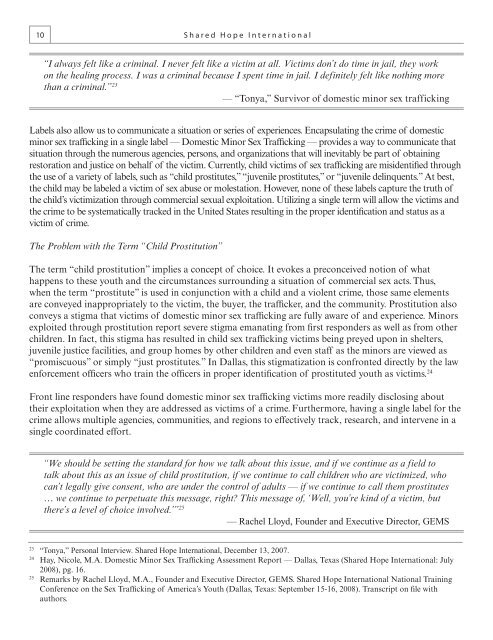By Linda A Smith Samantha Healy Vardaman Melissa A Snow
The National Report on Domestic Minor Sex Trafficking
The National Report on Domestic Minor Sex Trafficking
You also want an ePaper? Increase the reach of your titles
YUMPU automatically turns print PDFs into web optimized ePapers that Google loves.
10Shared Hope International“I always felt like a criminal. I never felt like a victim at all. Victims don’t do time in jail, they workon the healing process. I was a criminal because I spent time in jail. I definitely felt like nothing morethan a criminal.” 23— “Tonya,” Survivor of domestic minor sex traffickingLabels also allow us to communicate a situation or series of experiences. Encapsulating the crime of domesticminor sex trafficking in a single label — Domestic Minor Sex Trafficking — provides a way to communicate thatsituation through the numerous agencies, persons, and organizations that will inevitably be part of obtainingrestoration and justice on behalf of the victim. Currently, child victims of sex trafficking are misidentified throughthe use of a variety of labels, such as “child prostitutes,” “juvenile prostitutes,” or “juvenile delinquents.” At best,the child may be labeled a victim of sex abuse or molestation. However, none of these labels capture the truth ofthe child’s victimization through commercial sexual exploitation. Utilizing a single term will allow the victims andthe crime to be systematically tracked in the United States resulting in the proper identification and status as avictim of crime.The Problem with the Term “Child Prostitution”The term “child prostitution” implies a concept of choice. It evokes a preconceived notion of whathappens to these youth and the circumstances surrounding a situation of commercial sex acts. Thus,when the term “prostitute” is used in conjunction with a child and a violent crime, those same elementsare conveyed inappropriately to the victim, the buyer, the trafficker, and the community. Prostitution alsoconveys a stigma that victims of domestic minor sex trafficking are fully aware of and experience. Minorsexploited through prostitution report severe stigma emanating from first responders as well as from otherchildren. In fact, this stigma has resulted in child sex trafficking victims being preyed upon in shelters,juvenile justice facilities, and group homes by other children and even staff as the minors are viewed as“promiscuous” or simply “just prostitutes.” In Dallas, this stigmatization is confronted directly by the lawenforcement officers who train the officers in proper identification of prostituted youth as victims. 24Front line responders have found domestic minor sex trafficking victims more readily disclosing abouttheir exploitation when they are addressed as victims of a crime. Furthermore, having a single label for thecrime allows multiple agencies, communities, and regions to effectively track, research, and intervene in asingle coordinated effort.“We should be setting the standard for how we talk about this issue, and if we continue as a field totalk about this as an issue of child prostitution, if we continue to call children who are victimized, whocan’t legally give consent, who are under the control of adults — if we continue to call them prostitutes… we continue to perpetuate this message, right? This message of, ‘Well, you’re kind of a victim, butthere’s a level of choice involved.’” 25— Rachel Lloyd, Founder and Executive Director, GEMS23“Tonya,” Personal Interview. Shared Hope International, December 13, 2007.24Hay, Nicole, M.A. Domestic Minor Sex Trafficking Assessment Report — Dallas, Texas (Shared Hope International: July2008), pg. 16.25Remarks by Rachel Lloyd, M.A., Founder and Executive Director, GEMS. Shared Hope International National TrainingConference on the Sex Trafficking of America’s Youth (Dallas, Texas: September 15-16, 2008). Transcript on file withauthors.
















